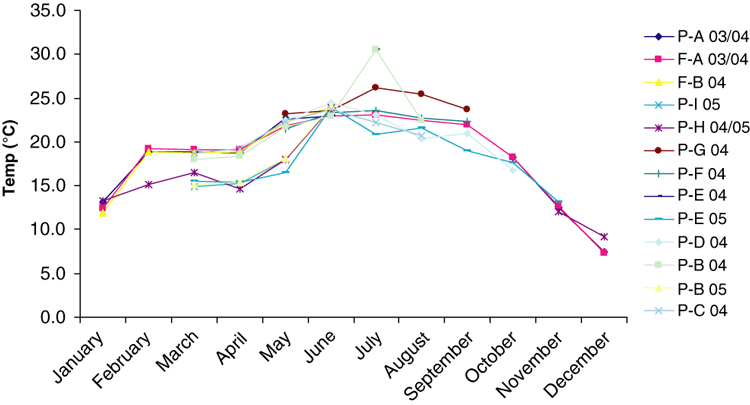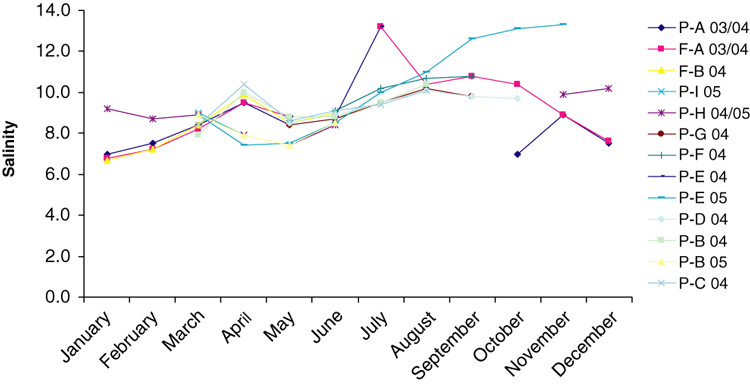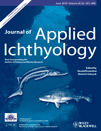Initial evaluation of various foods and diets in feed training wild-caught Atlantic sturgeon (Acipenser oxyrinchus oxyrinchus) onto a commercial diet
Introduction
Atlantic sturgeon is a historically important species of the Chesapeake Bay with current populations suspected of being extirpated. Developing captive broodstock populations is a potential restoration strategy for potential stock enhancement purposes in areas where sturgeon populations are extirpated, such as in the Chesapeake Bay. A key challenge in establishing a captive broodstock of wild-caught sturgeon is training fish onto commercial feed pellets in an aquaculture facility. Captured wild Atlantic sturgeon do not readily train onto commercial diets or, in some cases, even natural foods (Dilauro, 1998). However, he showed preliminary success in force feeding four captured Atlantic sturgeon by inserting gelatin encapsulated natural foods into the alimentary tract. Mohler (2003) suggested feeding practices such as soaking pellets in natural food solution and use of gelled diets with mixture of natural and commercial diets, but comparisons of these and other diets were not made. The present study evaluated various foods and feeding methods to train wild-caught Chesapeake Bay Atlantic sturgeon (Acipenser oxyrhincus) onto a commercial pelleted diet. Sturgeon held in flow-though tanks were fed using two methods: (i) force feeding, where a tube was inserted into the sturgeon’s alimentary tract and a natural food slurry was injected; and (ii) passive feeding, where sturgeon were offered natural foods or various mixtures of natural foods and ground commercial diet directly. Weight gain and the time to acceptance of the passive diets and commercial diet were measured.
Materials and methods
Atlantic sturgeon were collected from the Chesapeake Bay through a commercial fishing reward program established by the Maryland Department of Natural Resources (MDNR). Due to the unknown and limited catch of sturgeon, this study was conducted over a period of 3 years. Captured fish were transferred to the University of Maryland Horn Point Laboratory (HPL) and placed in 2841-L tanks, supplied with ambient filtered (2 μ) river water at a rate of 28 L min−1 (1.7 h exchange rate and negligible current). Upon arrival, fish were tagged with passive integrated transponder (PIT) tags (Biomark Inc., Boise, Idaho) and initial weight and length recorded. A wide variety of foods and diet types were evaluated to determine a successful regime. As fish were collected they were stocked into one of the 12 available tanks for this study at a maximum of two fish per tank. Once fish accepted commercial diet for a period of at least 1 month or weight gain was observed, they were removed from the study and stocked into other tanks. Fish were fed once daily in the morning, observed to determine acceptance evidenced by increased swimming behavior and oscillatory motion (Kasumyan, 1999), and gulping action with notable operculum movement. Uneaten feed was collected after 24 h to determine the degree of consumption. Fish weight was collected every 2 weeks throughout the duration of the project, although only initial and final weights were used in analyses. Water temperature, salinity and dissolved oxygen were measure once daily. Ambient water temperatures ranged from 7 to 30.5°C during the study and salinity ranged from 6.7 to 13.2 (1, 2, respectively). Recorded by daily visual observation were the length of time required for each fish to accept the passive diets that were either natural foods or an intermediate mixture (natural foods with ground commercial pellet), or the commercial diet (Nelson and Sons Silver Cup trout diet).

Monthly temperature profile for all treatments during the course of the study

Monthly salinity profile for all treatments during the course of the study
Forced feeding was conducted on two fish. Fish were anesthetized using 100 ppm MS-222 before being fed. Fish were given 30–60 ml of a slurry form of natural feed twice per week. A syringe was used to force the slurry through flexible tubing (9.5 mm OD) approximately 16–18 cm into the alimentary tract, as suggested by Dilauro (1998) and Brosse et al. (2002). Once fish were observed to feed, or set an amount of time of being force-fed, they were switched to two diet treatments: a commercial diet soaked in the slurry (F-A), or a hand-formed moist 50% natural food and 50% ground commercial diet prior to the commercial diet (F-B).
Passive feeding was accomplished by introducing natural foods directly into the fish tank. Ten passive feeding diet treatments were evaluated to initially assess foods that sturgeon would accept. These diets varied in consistency, form, and proportion of natural food and commercial diet (Table 1). Natural foods were comprised of shrimp (Panaeus vannamei), bloodworms (Glycera spp.), and squid (Loligo pealei). Once fish readily accepted the previously described passive diets, they were fed the commercial diet and monitored to verify acceptance, which was confirmed by visual observation when fish ate for several days. Fish that did not accept the commercial diet were returned to the passive diet and an attempt to transition to commercial diet was repeated.
| Treatment | Initial food | Transition diet |
|---|---|---|
| P-A | Shrimp, bloodworms, squid | Commercial pellet soaked in blended natural food |
| P-B | Shrimp, bloodworms | 50/50 pelleted diets |
| P-C | Shrimp, bloodworms | 75/25, 50/50, 25/75 pelleted diets |
| P-D | Shrimp, bloodworms | 50/50 moist pellet |
| P-E | 50/50 moist pellet | n/a |
| P-F | Shrimp, bloodworms blended with Knox gelatin | 75/25, 50/50, 25/75 pelleted diets |
| P-G | Shrimp, bloodworms blended with Knox gelatin | 50/50 pelleted diets |
| P-H | 50/50 pelleted diet in Knox® gelatin | n/a |
| P-I | Clams | 50/50 moist pellet of clams and commercial diet |
Data analysis
Earlier preliminary feed acceptance observations suggested that large fish were more difficult to train onto a commercial diet. We therefore decided to analyze feed acceptance and fish size. Sturgeon were divided into two weight groups, small (<10 kg) and large (>10 kg). An analysis of variance (anova, SPlus 6.1) was used to compare treatments to weight gain, time to acceptance of passive food, and time to acceptance of commercial diet. Since very few (n = 5) large fish (>10 kg) were used in the study, statistics comparing diet treatments were completed using only results from the smaller fish (Table 2).
| Diet treatment | N= | Mean initial weight(kg ± SD) | Mean treatment weight gain difference(kg ± SD) | Mean time to acceptance of passive diet(weeks ± SD) | Mean time to commercial diet(weeks ± SD) |
|---|---|---|---|---|---|
| F-A | 1 | 8.84 | −2.5 | n/a | 32 |
| F-B | 1 | 3.7 | 0.3 | n/a | 16 |
| P-A | 3 | 5.1 ± 1.75 | −0.1 ± 1.2c | 6 ± 4 | 29 ± 9a |
| P-B | 9 | 2.24 ± 1.83 | −0.4 ± 1.1b | 3 ± 3a | 11 ± 3b |
| P-C | 3 | 2.26 ± 1.17 | 2.2 ± 0.2c | 2 ± 0 | 9 ± 3b |
| P-D | 7 | 2.17 ± 0.93 | 0.3 ± 0.7 | 9 ± 7 | 13 ± 7b |
| P-E | 12 | 1.45 ± 0.55 | 0.3 ± 0.8c | 7 ± 7 | 9 ± 7b |
| P-F | 4 | 1.14 ± 0.59 | 1.2 ± 0.7 | 5 ± 6 | 11 ± 6b |
| P-G | 3 | 1.24 ± 0.51 | 1.7 ± 0.1a | 4 ± 3 | 9 ± 7b |
| P-H | 5 | 3.55 ± 1.67 | −0.5 ± 0.9b | 14 ± 6b | 16 ± 7 |
| P-I | 7 | 1.26 ± 0.43 | 0.4 ± 0.6 | 5 ± 3 | 8 ± 3b |
- F-A, sturgeon force fed blended food initially then introduced commercial diet soaked in slurry; F-B, sturgeon force fed blended natural food initially, then switched to passive feeding; P-A, commercial pellets soaked in natural food mixture; P-B, 50/50 mixture of natural foods/commercial diet mixture prepared pellet; P-C, 75/25, 50/50, 25/75 mixtures of natural food/commercial diet prepared pellet; P-D, initial feeding of shrimp/bloodworms followed by a moist 50/50 mixture of shrimp/bloodworms and commercial pellet; P-E, moist 50/50 mixture of shrimp/bloodworms and commercial diet; P-F, gel diet as initial diet followed by the 75/25, 50/50, 25/75 mixtures of natural food/commercial diet prepared pellets; P-G, gel diet as initial diet followed by the 50/50 mixture of natural food/commercial diet prepared pellets; P-H, initial diet of 50/50 mixture of natural food/commercial diet prepared in gel form; P-I, initial feeding of clams followed by a moist 50/50 mixture of clams/commercial pellet.
Results
Table 2 summarizes the feeding trials from September 2003 to October 2005 for sturgeon <10 kg. Sturgeon took from 2 to 14 weeks to accept the various passively introduced diets, and an additional 2 to 23 weeks to successfully train to commercial diet. Weight gain among treatments and individual sturgeon varied and ranged from 0.3 to 2.2 kg (Table 2).
The two force-fed sturgeon did not readily accept the commercial diet following tubal feeding. The F-A fish was force-fed for 16 weeks before it was offered commercial pellets soaked in the natural food slurry. Though this fish was observed gaining weight after 30 weeks and trained onto commercial pellets after 32 weeks, it lost 2.5 kg of its initial weight by the end of the study. The other forced-fed fish, F-B, was tube-fed for 8 weeks before being switched to passive feeding of cut shrimp and bloodworms; weight gain was 0.3 kg for this fish over the entire feeding period of 20 weeks (Table 2).
Sturgeon in the P-C (n = 9) treatment showed the shortest mean (±SD) time (2 ± 0 weeks) to acceptance of the initial passive diets and one of the shortest mean times (9 ± 3 weeks) to accept commercial diets (Table 2). This treatment also showed the greatest significant mean weight gain (2.2 ± 0.2 kg). Other treatment with short mean times to acceptance of commercial diet include: P-E with 9 ± 7 weeks to accepting commercial diet; P-G with 9 ± 7 weeks to accepting commercial diet and the second greatest mean weight gain (1.7 ± 0.1 kg); and P-I having a mean time of accepting commercial diet of 8 ± 3 weeks. The P-J diet, initially of grass shrimp followed by a prepared 50/50 pellet, ate the grass shrimp but did not accept the 50/50 prepared diet after two attempts, and therefore was re-trained using the P-B diet treatment that was exhibiting good success at that time.
Larger sturgeon (>10 kg) were fed three feeding diets: P-B, P-C and P-E (Table 3). The P-B treatment resulted in a mean 1 ± 1.4 kg weight loss and took 19 ± 3.5 weeks until acceptance of commercial diet. Only one large fish was fed using the P-C diet, which resulted in a 2.8 kg weight loss by the end of the study; it took this fish 2 weeks to train to passive feed and 9 weeks to accept commercial diet. The P-D diet regime resulted in a mean weight loss of 4.6 ± 0.8 kg and 12 ± 12.7 weeks until acceptance of commercial diet. No statistical difference (P < 0.05) was found between weight groups (<10 kg vs >10 kg) and time to commercial feed (P = 0.31). The large weight group (>10 kg) consisted of only five sturgeon, however, due to limited capture of fish this size.
| Diet Treatment | N= | Mean initial weight(kg ± SD) | Mean treatment weight gain difference(kg ± SD) | Mean time to acceptance of passive(weeks ± SD) | Mean time to commercial diet(weeks ± SD) |
|---|---|---|---|---|---|
| P-B | 2 | 14.94 ± 1.48 | −1 ± 1.4 | 2 ± 1 | 19 ± 3.5 |
| P-C | 1 | 29.48 | −2.8 | 2 | 9 |
| P-D | 2 | 13.82 ± 0.11 | −4.6 ± 0.8 | 1 | 12 ± 12.7 |
- P-B, 50/50 mixture of natural foods/commercial diet mixture prepared pellet; P-C, 75/25, 50/50, 25/75 mixtures of natural food/commercial diet prepared pellet; P-D, initial feeding of shrimp/bloodworms followed by a moist 50/50 mixture of shrimp/bloodworms and commercial pellet.
Discussion
Numerous studies have identified various characteristics of diets related to feed acceptance and preference of live and artificial diets by sturgeons, however, the vast majority of these involve hatchery-reared larvae and juveniles. Bardi et al. (1998) relate acceptance and performance of Gulf of Mexico sturgeon (Acipenser oxyrhinchus desotoi) larvae fed Artemia, blackworms (Lumbriculs variegates), commercial, and experimental diets. Furthermore, Bardi et al. (1998) developed specifics on diet switching times for various diets and larval age, and related the importance of smell and palatability to preference by sturgeon. Klassen and Peake (2008) showed success in transitioning larval lake sturgeon (A. fulvescens) from Artemia onto black fly larvae (Simuliidae) and bloodworm (Chironomidae), and further suggested that food size is important in acceptance. Much of the definitive work on sturgeon feeding behavior and diet preference has been conducted by A. O. Kasuyman and colleagues. In a series of studies with beluga (Huso huso), green sturgeon (A. medirostris), Persian sturgeon (A. persicus), Russian sturgeon (A. gueldenstaedtii), Siberian sturgeon (A. Baerii) and stellate sturgeon (A. stallatus), he and others identified the specifics of olfaction, physical feeding behaviors, and response to a variety of amino acid ‘food flavors’ as chemical stimuli (Kasumyan and Kazhlaev, 1993; Kasumyan, 1999; Shamushaki et al., 2008). These and related studies have contributed greatly to larval and juvenile sturgeon feeding practices used today in hatcheries.
This study provides initial investigation of acceptance of a variety of natural foods and diet formulations by wild-caught Atlantic sturgeon in an effort to develop diets and practices that will enable development of a captive broodstock population. This is essential for future stock enhancement research in the U.S. since policy requires population augmentation to use broodstock of the same or adjacent tributary (ASMFC, 2006). Studies on feeding wild-caught Atlantic sturgeon are limited. Dilauro (1998) had success in force-feeding four captured Atlantic sturgeon by inserting gelatin encapsulated natural foods into the alimentary tract, suggesting this as one method to initiate captive feeding behavior. Mohler (2003) stated the difficulty of feeding wild fish, but observed success with thawed shrimp and bloodworms, and further suggested that mixing those natural foods with commercial diet in a gel mixture may be successful. We attempted to build on this work and screen a variety of foods and the two methods suggested by Dilauro (1998) and Mohler (2003).
One observation of this study is that training wild-caught sturgeon is time intensive. Attaining the least amount of time to train fish decreases feeding labor and reduces the need for natural foods, which are expensive and negatively impact water quality, compared to commercial pelletized diets. We determined that forced tubal feeding required greater time than passively feeding fish and was unnecessary, since passive treatments were very successful and eliminated stress associated with anesthesia and tubal insertion of forced feeding.
Acceptance varied among the passive diets evaluated. The shortest acceptance time for passive feeding in the initial diet was observed with P-C, P-B, P-F, and P-I, respectively, and ranged from 2 to 5 weeks. The time to acceptance of commercial diets ranged from 8 ± 2.7 weeks to 32 weeks, with the shortest time to training observed from the P-E (moist 50/50 mixture of shrimp/bloodworms and commercial diet) and P-H (50/50 natural food and commercial diet in a gelatin form). Other diets exhibiting relatively short times to accept a commercial diet included: P-I and PD. In addition, diets P-F and P-I took only 2 weeks to train from acceptance of a passive diet onto a commercial diet. The variation of acceptance time may be caused by several factors, including water temperature and the effect on a sturgeon’s sensory capability, the diet and the degree of chemical odor released in the water, and physical characteristics of the diet (Kasumyan, 1999). Average monthly temperatures were similar among treatments (Fig. 1) and probably not likely to cause differences. The various natural foods, pellets, gelatin based and pelleted diets used have different textures that could affect acceptance. We did not attempt to characterize the compounds or flavors released by the diets, as we built on earlier known accepted foods and the study goal was to determine which foods will help transition wild fish to accept commercial diet. We did observe relatively good success of the diets used and showed that training is possible. Initial use of natural foods, followed by an intermediate diet composed of natural foods and ground commercial pelleted diet, can be accomplished with various foods, and was an effective method to train fish to accept a commercial pelleted diet.
Acknowledgements
This project was funded as a subcontract to the MDNR Fisheries Service by a United States Fish and Wildlife Service (USFWS) award. The authors want to thank Steve Minkkinen, USFWS, for his support of this project and assistance in the reward program, Matthew Baldwin and Chuck Stence, MDNR, and Craig Shirey, Delaware Division of Fish and Wildlife, for their assistance in collection and transport of fish, Angie Hengst for assistance in data analysis, Sarah Wood, University of Maryland Eastern Shore, for assistance in making pelleted diets, and Mark Rath and Sarah Marnell, HPL, for help in feeding sturgeon as well as other management duties.




